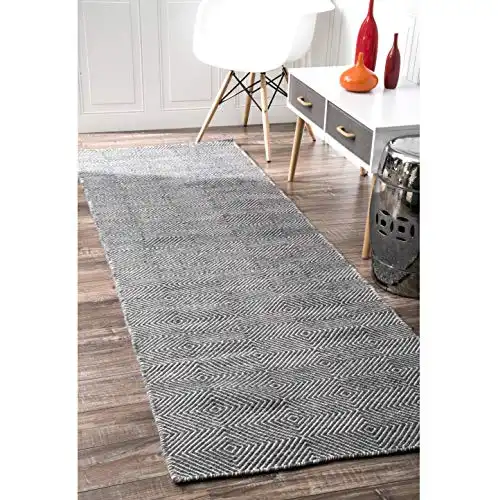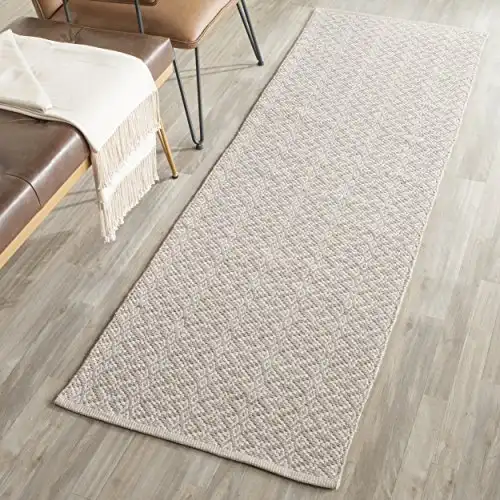- You are here:
- Home »
- Non Toxic Home Poducts »
- Are Polyester Rugs Toxic?
Are Polyester Rugs Toxic?
There are many factors to consider when choosing a rug for your home. One of the most important is the material it is made from, as this can greatly impact your health. Polyester rugs, for example, are made of petroleum-based compounds, which have been linked to different health issues ranging from headaches and skin irritation to cancer.
This article will explain the risks associated with polyester rugs, what makes them toxic, and the best alternatives.
What Are Polyester Rugs?
Polyester rugs are made of synthetic fabric. They are usually cheaper than other types of rugs and are easy to care for. Polyester is a synthetic fabric that is made from purified terephthalic acid and monotheluene glycol. These two materials are combined together through a chemical reaction that uses high pressure and heat. The resulting fabric is extremely tough and durable.
However, polyester is made from non-renewable resources, so it is not biodegradable. Extracting fossil fuels to create polyester also releases high levels of carbon dioxide into the atmosphere, which can harm the environment. The polyester may be further treated with flame retardants, dyes, and chemicals that make the rug stain resistant.
On top of that, these rugs may have synthetic padding or backing glued to them, which can also be made of polyurethane or synthetic latex. These materials are not biodegradable either, and they can release harmful chemicals into the air if they are burned.

What Makes Polyester Rugs Toxic?
Different elements of a polyester rug can make it toxic and unsafe for use in your home. Some of these include:
Polyester Fibers
Polyester is a synthetic fiber that is made from petroleum-based products. These fibers can release harmful chemicals like VOCs and formaldehyde into the air.
The Backing
The backing of a polyester rug is often made from synthetic latex or other potentially toxic materials.
The Dyes
Many synthetic rugs use toxic dyes to achieve their vibrant hues. This chemical process of using dyes has been found to release dangerous chemicals such as heavy metals, aniline, sodium chloride, toluene, benzene, alkylphenol ethoxylates, and formaldehyde. These substances can be harmful to your health, and they can also pollute the air and water.
Glues and Adhesives
The glues are used to bind the fibers and backing together. The carpet glues can off-gas, releasing toxic substances that can irritate your respiratory system, eyes, and skin.
Flame Retardants
Many polyester rugs are treated with flame retardants, chemicals that help prevent the fabric from catching fire. However, these chemicals can be hazardous if they are breathed in or if they come into contact with the skin. Inhaling the fumes created by flame retardants can lead to respiratory problems, and it has even been linked to cancer.
Stain and Water Resistant Treatments
These treatments are usually applied to the surface of the rugs to make them more durable. However, these chemicals, known as PFCs, can be harmful to your health.
Permanent Press Finishes
These finishes are applied to the surface of the rug to prevent wrinkles. They’re made of chemicals that can be toxic and cause skin irritation.
So there are many different elements that can make synthetic rugs, including polyester, unsafe for use in your home. If you are concerned about your family’s safety, it is best to avoid using polyester.
Read More: Best Non-Toxic Carpet Odor Eliminators
What Else Makes Polyester Rugs a Bad Choice?
Polyester rugs are not only potentially harmful to your health but also bad for the environment. The production of polyester emits high levels of carbon dioxide into the atmosphere, which can contribute to climate change. In addition, polyester is made from non-renewable resources, so it is not a sustainable choice. Polyester rugs are also not biodegradable, so they will stay in landfills for years after you’ve disposed of them.
They are also not durable, so you will likely have to replace them more often than you would other types of rugs. It means that over time, polyester rugs can actually end up costing you more money than if you had just chosen a different material in the first place. They also take thousands of years to decompose in a landfill.
These rugs can also be a source of microplastics. When you wash them, the synthetic fibers can break down and release microplastics into the water. These tiny particles can then end up in the ocean, where they can be ingested by marine life.
On top of that, because polyester is not breathable, these rugs can trap moisture, leading to mold and mildew growth. It can be the case, especially if you place it on a wooden floor, as the moisture can cause the wood to warp and rot.
If you are looking for a rug that is safe for your family and the environment, you should avoid polyester rugs and choose one made from natural fibers like wool or cotton. These rugs are sustainable and will not off-gas harmful chemicals into your home.
Read More: Are Carpets Toxic?
Best Non Toxic Rugs
The best alternatives to polyester rugs are ones that are made from natural fibers like wool, jute or cotton. These rugs are sustainable and will not off-gas harmful chemicals into your home.
Wool Rugs
There are many reasons why you might want to consider investing in a wool rug. For one, wool is a naturally biodegradable and hypoallergenic material, making it a great choice for people with allergies or sensitive skin. In addition, wool is naturally fire-resistant, so there’s no need for harmful chemical treatments.
Wool is also a tough material; if you look after it, it will last for years. Of course, one downside of wool is that finding the right organic certified wool rug can be expensive. However, the investment is usually worth it in the long run because many wool rugs are treated with dyes and chemicals that can be harmful to your health.
When purchasing a wool rug, be sure it’s Oeko Tex or GOTS certified so you know it’s toxin free. It’s best to avoid putting wool rugs in humid areas, such as bathrooms, because although it’s naturally water repellent, it may develop mildew at some point. With proper care, your wool rug will be a beautiful and durable addition to your home for years to come.
Jute Rugs
Jute is a soft, versatile natural fiber that can be used for a variety of purposes around the home. It is made from the green stalk of the plant rather than the leaves, resulting in a softer fabric that is similar to wool. However, this softness also makes jute rugs less durable than other fabrics, so it is best suited for low to medium-traffic areas of the home.
Jute may also shed slightly, so regular vacuuming is recommended. Despite its drawbacks, jute is a beautiful, eco-friendly material that can add a touch of natural warmth to any space.
Cotton Rugs
Cotton is a popular choice for rugs because it is soft and comfortable, and it is also an affordable material. However, most cotton is genetically modified and heavily sprayed with pesticides, making it an environmentally-unfriendly choice. If you’re looking for a more sustainable option, look for a rug made of organic cotton.
Organic cotton is grown without the use of pesticides or other harmful chemicals, making it a safer choice for you and the environment. Cotton is also a very absorbent material, so be careful about spills and stains.
That said, these machine-washable rugs are generally easy to maintain. Remember that cotton rugs are less durable than those made from synthetic materials, so they’re best used in low-traffic areas.
Read More: Best Natural Rug Cleaning Tips
Are Polypropylene Rugs Better Than Polyester?
Polypropylene and polyester are the most popular materials used to make rugs. They are synthetic fibers, meaning they are made from petroleum products. Polypropylene is a type of plastic, while polyester is a type of textile fiber.
Polypropylene rugs are often considered to be better than polyester rugs because they are more durable and stain-resistant. They are also easier to clean since they don’t absorb liquids as much as polyester rugs do. Polypropylene rugs are also less likely to fade in sunlight than polyester rugs.
However, polypropylene rugs can be more expensive than polyester rugs. They also tend to be less soft and plush, which might not be ideal if you’re looking for a rug that’s comfortable to walk on.
Polypropylene rugs also contain toxic chemicals that can be released into the air, which can be harmful to your health. They can have the same negative impact on air quality as polyester rugs do in your entire house because they contain phthalates, flame retardants, and PFCs.
It depends on your preferences if you’re trying to decide between a polypropylene and polyester rug. Both types of rugs have their own advantages and disadvantages. But if you’re after a non toxic rug, you might want to avoid synthetic rugs and choose a different material instead.
Read More: Polypropylene vs Wool Rug
Conclusion
Polyester rugs can be harmful to your health and the environment. They are made from petroleum products and contain toxic chemicals that can be released into the air, causing a range of health problems.
If you’re looking for a rug that is safe for your family and the environment, you should choose one made from natural fibers like wool or jute. These rugs are more sustainable and will not off-gas harmful chemicals into your home.
About the Author Kamila Flieger
My name is Kamila, and I'm passionate about researching non-toxic, organic products for the home. I believe it's so important to create a safe and healthy environment for our families, and I enjoy helping others do the same.




